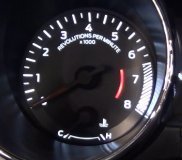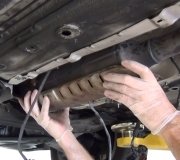Hi there,
Check that the brake booster is not leaking vacuum this will affect the idle as for the exhaust, there are a few schools of thought on this, I am one that believes that maintaining back pressure is important so I would leave the muffler alone I wont go into all the techno guff but for my money back pressure is important in the over all efficiency of the engine.
Ok, ok, here is the techno guff, something I had on the PC I found.
Back pressure and Exhaust Pipe Size
Q. Why do engines need back pressure? Won't a larger exhaust pipe give my 944's naturally aspirated engine more power?
A. I've always understood that you want to keep the exhaust gases moving, even once you get them out of the cylinder. One thing that will cause the gas to slow down is a sudden decrease in temperature, which is one reason why auto makers don't try to cool the exhaust manifold. The other thing that can cause a decrease in flow velocity is rapid expansion and turbulence, like going from a small passage (like the exhaust port in the head) to a 6-inch pipe. A smaller-diameter pipe geometry will tend to keep the flow rate up, but it will also lose heat more quickly (less exhaust gas per linear inch of pipe). However, a large pipe will slow the velocity due to expansion. Worse still, the exhaust is constantly cooling from the moment it leaves the cylinder, meaning it's getting denser and slower. See the problem here? It's all about compromises. The proper pipe size is going to be influenced by the flow rate (volume rate, which is related to RPM and engine displacement), exhaust velocity (again related to RPM), exhaust temperature (constantly changing, and as high as 2,000&Mac251;F, if I remember right), and undoubtedly an array of other factors. All of this is dependent on the application: is this a street car, a race car, or something in between? Where will the engine spend most of its time? Idle, full throttle, part throttle?
I've also heard the thing about back pressure, but I believe that they're really talking about flow velocities. That is, if you can keep the exhaust gases moving in the exhaust pipe, they will cause a small reduced-pressure area behind the closed exhaust valve, in the exhaust. This happens because the gases have momentum. They move away from the valve, creating a localized reduction in pressure. When the exhaust valve opens, this reduced-pressure zone will help evacuate the burnt gases from the cylinder. Or so the theory goes, as I understand it (two disclaimers there).
The bottom line is that Porsche has probably already considered all this and other factors when sizing the exhaust on the 944. Unless you're significantly increasing the flow rate, you're likely to cause more harm than good.
Q. So what if you insulate the exhaust pipe, in an attempt to keep the flow rate up and cool the engine compartment, which would also benefitting the intake?
A. Flow rate is impacted by a number of different things in addition to raw temperature, including the surface roughness and pipe geometry. The problem with wrapping the exhaust system is that you're only postponing the inevitable: the gases will eventually cool, even if it's just a little further downstream, and there must be more than 6 feet of exhaust pipe in a 944.
You also hit upon another problem: materials. I've read of manufacturers using a ceramic lining inside the exhaust pipes to reduce the temperature loss, but I don't know how much difference it really makes. Also, ceramic-lined pipes may be aimed more towards reducing under-hood temperatures, which you've indicated would be impacted, than performance issues. As for wrapping, you're going to start delving into the mechanics of materials if you start subjecting the exhaust manifold to more temperature. Of course, that's one reason why the intake and exhaust sides of the 944 are on opposite sides of the vehicle, to isolate (as much as possible) the two systems. While it's true that cooler air will result in a denser charge and slightly more power, the air pressure is usually much easier to increase, hence turbocharging. After all, we're talking about engines that run at >200F already. It might make more sense to wrap the intake manifold rather than the exhaust manifold, if your goal is to get the coolest charge into the cylinders, or maybe run your intake through the A/C system.
If you're after no-holds-barred performace, take a look at the funny cars: short exhaust pipes that rise vertically into the airstream that rushes by the car as it storms down the 1/4-mile strip. Keep in mind that any efficiency you get while working on the exhaust side won't increase the efficiency of the intake or the combustion chamber itself. You're really talking about an entire system here, and just changing the exhaust won't necessarily get you any noticeable performance increases unless you're only trying to shave tenths or hundredths of a second off your 1/4-mile time. If you want more power without turbocharging, you'd be better off looking into a combination of increased displacement, increased compression ratio, 4- and 5-valve heads, more radical camshafts, intake runner changes, etc. Or you could just get a 968 and have all these things already engineered by Porsche.
The way I figure it, I bought my NA 944 for its beautiful handling, daily usability, and decent economy. Mustangs and Camaros have nothing to fear at stoplights, but watch out for the corners.
Boring stuff hay.
SPONSORED LINKS
Tuesday, July 21st, 2009 AT 6:38 AM



